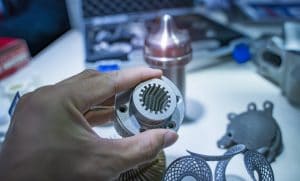 The advent of heat exchangers has been an important part of technological advancement for several decades. Appropriately, the technologies used to design and create heat exchangers have also evolved as manufacturers have implemented more advanced systems to meet increasing demand. One of the most impactful of those advancements has been the use of 3D printing to implement rapid prototyping into the production process. The technology allows companies to rapidly create prototypes of parts and components to test them in real-world applications and make adjustments, when necessary, before the design goes into final production.
The advent of heat exchangers has been an important part of technological advancement for several decades. Appropriately, the technologies used to design and create heat exchangers have also evolved as manufacturers have implemented more advanced systems to meet increasing demand. One of the most impactful of those advancements has been the use of 3D printing to implement rapid prototyping into the production process. The technology allows companies to rapidly create prototypes of parts and components to test them in real-world applications and make adjustments, when necessary, before the design goes into final production.
What is rapid prototyping?
Rapid prototyping is the ability to create a highly detailed and accurate model of a heat exchanger unit or component. This gives heat exchanger manufacturers a significant advantage when it comes to designing heat exchangers for advanced applications. For example, every component can be prototyped and tested to iron out any discrepancies that could affect the final component’s operation. Adjustments can be made to the design and tested again until the measurements are perfect. After rapid prototyping is complete, the heat exchanger unit can be created with greater assurance that it will be successful.
3D printing as part of the manufacturing process
The more companies utilize 3D printing and rapid prototyping, the higher the bar has been set for producing heat exchangers faster and with greater reliability. However, its main benefit has been making collaborative design and manufacturing much easier and more successful. Designing modern heat exchangers takes input from different areas of expertise, including thermal management, engineering, design, manufacturing, and more. With the ability to rapidly prototype parts and components, teams can easily spot areas where designs may not have transferred appropriately. Teams can work together to correct the discrepancy quickly and efficiently so clients don’t have to wait while their heat exchangers have to be redesigned.
Benefiting from heat exchangers faster
Advanced forms of heat exchanger manufacturing have been a boon to the companies that make them, but even more so to the clients that rely on their products. Companies that seek to implement heat exchangers often do so out of a significant need to upgrade their thermal management systems. That means the sooner they can receive their heat exchangers, the faster they can implement that upgrade. Manufacturers that utilize rapid prototyping can deliver solutions faster to their clients, giving them a significant leg up on their competitors who don’t.
For more information about the value of rapid prototyping for making heat exchangers, call Noren Thermal Solutions in Taylor, TX, at 866-936-6736.







